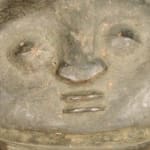Bamileke Wooden Healer's Bowl, 20th Century CE
Wood
15.25 x 11
PF.4517
Further images
The world of sorcery, witchcraft, healing and divination in African culture appears to Western eyes as very confusing and somewhat frightening. The reliance on the intervention of spirits in healing...
The world of sorcery, witchcraft, healing and divination in African culture appears to Western eyes as very confusing and somewhat frightening. The reliance on the intervention of spirits in healing is alien to our minds. Yet, there is an inherent logic and profound system of rules and procedures in these esoteric arts that go back thousands of years. In understanding this it is important to separate good from bad, a sorcerer who casts an evil spell and a healer who guards a person from such malevolent influences. Healers and diviners call upon spirits to aid them in helping a person, and can use their potions and psychic power to rid a body of unwanted entities.
A healer of the Bamileke would be well versed in various things, particularly in the herbs and plants that grow in their region. Many would have an encyclopedic knowledge of fauna and flora, and know exactly what mixture to prepare for a vast variety of ailments. A bowl such as this very lovely example would have been used for such preparations. Dried herbs, roots, and bark may have been blended for small pouches worn on the body. Gooey concoctions of plants, animal fat, and sometimes earth were kneaded into a poultice for skin inflammations. This bowl absolutely exudes benevolence, compassion, and even a sense of humor. The two figures on the lid may be spiritual entities pertaining to specific treatments, ancestral figures, or perhaps healers themselves giving each other power in a friendly embrace. The face on the side radiates good cheer and hope with a delightful expression. This bowl can be seen as both a raw element of forest and earth, like the materials it held, and also a symbol of the sophisticated art of healers-whose skills the Western world is only beginning to appreciate.
A healer of the Bamileke would be well versed in various things, particularly in the herbs and plants that grow in their region. Many would have an encyclopedic knowledge of fauna and flora, and know exactly what mixture to prepare for a vast variety of ailments. A bowl such as this very lovely example would have been used for such preparations. Dried herbs, roots, and bark may have been blended for small pouches worn on the body. Gooey concoctions of plants, animal fat, and sometimes earth were kneaded into a poultice for skin inflammations. This bowl absolutely exudes benevolence, compassion, and even a sense of humor. The two figures on the lid may be spiritual entities pertaining to specific treatments, ancestral figures, or perhaps healers themselves giving each other power in a friendly embrace. The face on the side radiates good cheer and hope with a delightful expression. This bowl can be seen as both a raw element of forest and earth, like the materials it held, and also a symbol of the sophisticated art of healers-whose skills the Western world is only beginning to appreciate.











